Making Cocktails
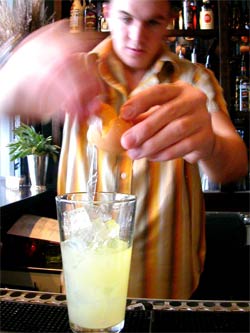 Equipment used to make Cocktails
Equipment used to make Cocktails
You don't need to be a trained barman to mix cocktails. Mixing and enjoying cocktails is about experiencing and experimenting with new flavours and learning to appreciate what ingredients work together and why. If you have already acquired the basic ingredients, it is sufficient to start out with a bar equipped with little more than a Cocktail Shaker [pictured below] and plenty of ice. (Interestingly, antecedents of this humble device can be traced to 7000 BC in South America. In 1520 Cortez wrote to King Charles V of Spain from the New World of a certain drink made from cacao, served to Montezuma with much reverence, frothy and foaming from a golden cylinder).
If you don't have a cocktail shaker you can use a jar with a close fitting lid.
Then the following implements are also helpful, but not essential for many cocktails:
- 'Jigger' or measure
- Strainer
- Bar Spoon
- Muddling Stick and of course, depending upon the types of drinks you find yourself serving, glassware.
Cocktail glasses come in four different basic types, detailed below:
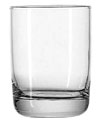
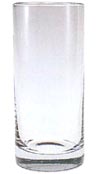
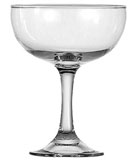
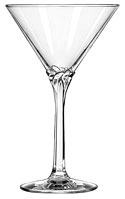
(a) First, there are the glasses known as rocks glasses, also known as tumblers. These glasses are usually short and broad glasses, with straight or slightly sloping sides. They normally hold about 125ml and are used for spirits with ice, fruit juices and short drinks.
(b) Second, there is the highball glass. These glasses are usually of medium width, and are tall with straight or slightly sloping sides. They normally hold between 200 and 300ml and are used for long drinks with ice.
(c) Third, the champagne glasses, are of two different kind. The most common, the champagne flute, is a tall and narrow glass with a stem. Champagne flutes have thin-glassed sides, and the long, tapering sides can curve both inward and outward. A champagne flute holds approximately 150ml. The second type of champagne glass is the less-known champagne saucer. The champagne saucer is a broad and shallow glass with a stem. The broadness and shallowness of the glass make the champagne loose its fizz quickly, and the glass is therefore less popular than it once was. It is still, however, in use, and such cocktails as the Margarita use exclusively such glasses.
(d) Fourth is the group known as cocktail glasses and sometimes referred to as a Martini glass. These are the 'classic ' cocktail glasses; stemmed and with sharply sloping sides, making a Y-shape when seen from the side. The glass holds about 90ml and is best suited for short, strong drinks like Martinis.
In addition to these glasses, some drinks, such as the Pina Colada or Irish Coffee use special glasses. Unless you are really serious about mixing your cocktails, you don't really need to buy such glassware. There are also other glasses available that will work just fine with cocktails. Use your imagination, but remember that plastic glasses (or shakers, jugs, mixing glasses, or other such equipment for that matter) are inappropriate.
To complete the home bar, other items which may be useful include:
- Bottle Pourers (with standard shot measures)
- Bottle Stoppers
- Ice Bucket
- Ice Crusher
- Juicer
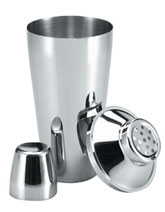 Methods of Creating Cocktails
Methods of Creating CocktailsThe Art of making a Cocktail is essentially about balancing each of the component flavours. A properly made Martini, for instance, is one in which all of the ingredients blend together in such a way that it each element is contributes to the overall flavour profile without over-powering. In the Martini, Gin produces a slightly fiery sensation from its alcohol content and offers distinct botanical notes from juniper berries and other herbs and spices. Dry vermouth has the softer, almost buttery texture of the wine which is its base, as well as the rounder flavours of the herbs used in its recipe. Orange bitters, which is sometimes used, is like adding vinegar to temper the sweetness and round out the flavour of certain dishes. In the Martini it has a spicy flavour with a slight hint of sweetness, providing a pleasant bridge between the gin and vermouth. Lastly the water provides a non-descript toning down of all the components in order to make the cocktail gentle and elegant.
Of course, not all cocktails are made in the same manner and as the ingredients vary, so do the methods by which to mix. The most frequently used techniques are the following:
- Shaking:The cocktail is mixed by hand in a cocktail shaker. The shaker is first filled three quarters with ice, preferably cubes, as crushed ice will tend to melt and dilute the cocktail. The ingredients are then poured on top of the ice, in order of alcohol content (highest first). When shaking a cocktail, hold the shaker in both hands, one hand on the top and the other supporting the base of the shaker, and shake vigorously. When water has begun condensing on the outside of the shaker, the cocktail is sufficiently chilled, and the cocktail should immediately be strained into the glass. In general, shaking creates a colder cocktail than stirring does, but also a more cloudy one.
- Stirring:The cocktail is stirred with a glass or metal rod in a mixing glass, before the cocktail is strained into a glass. As with shaking, crushed ice should not be used, and water condensing on the outside shows that the cocktail is finished.
- Blending:An electric blender is used to mix fruit juices, alcohol, fruit, etc. Blending is an excellent way of mixing ingredients which do not blend easily in any other way. Blend the cocktail till it has reached a smooth consistency. If the recipe requires ice, add crushed ice last, but be careful not to add too much, as the cocktail may be watered down. Blending is a much disputed method of mixing a cocktail, and in general, blending should be avoided unless the recipe demands it.
-
Building:When building a cocktail, the ingredients are poured into the glass in which the cocktail will be served. Usually, the ingredients are floated on top of each other, but occasionally, a swizzle stick is put in the glass, allowing the ingredients to be mixed.
Tips & Tricks...
Muddling
Cocktail recipes sometimes call for certain ingredients to be "Muddled". Muddling is the crushing of fruit or herbs in order to release their flavours. You can use a muddler, a pestle or even the end of a rolling pin by pushing down with a twisting action.
James Bond has immortalised the Martini in popular culture as a symbol of sophistication and style.
Salting a Glass
Some recipes also require that the rim of a glass be salted. To achieve this, moisten the edge of a glass with a wedge of lime and dip the upturned glass into a saucer of salt. For sugar, chocolate, coconut etc moisten the edge with a damp sponge first and then dip into the saucer.
Ice
Ice is an essential ingredient to great cocktail making. Cocktails should be served icy cold. Ideally, a properly prepared cocktail should be as close to freezing as possible. You can do this by either shaking the drink with ice, or stirring it. Both do the job equally well.
Be careful when using cordials and liqueurs in Cocktails. Most of these are very sweet and not only can make an otherwise good mix too sweet, but lose their own character through dilution. Midori is a good example of a liqueur that should be used very sparingly - its flavour quickly overpowers any blend and makes for a sickly sweet or 'cloying' drink.
If you are relatively new to cocktails, try out this experiment which demonstrates the impact ice can have. Returning again to the example of a Classic Martini recipe (featuring gin and vermouth), chill the serving glass, garnishes (olives etc) and vermouth in the fridge and place the gin in the freezer. Using the chilled ingredients without any ice, mix these together in the serving glass and drop in the olive or sliver of lemon zest. When you taste the finished cocktail, it will be overwhelming in strength. If you then make the recipe using the ingredients stirred with ice in a cocktail shaker and then strained into your cocktail glass, the difference will be quite apparent. The use of ice changes the composition of the cocktail. By reducing the temperature of the liquid and diluting it slightly, the ice mellows the so called 'burn' effect of the strong alcoholic ingredients. Yet at the same time, the addition of water releases and enhances the flavours and aromas of many spirits. This is a method that is widely used in tastings of products such as malt whisky to appreciate its depth and complexity of flavours. Rather than taste the whisky neat, a little still water is added and gently swirled around the glass to mix the water and whisky together. When you then nose it before and after the water is added, the difference is marked.
Liqueurs
